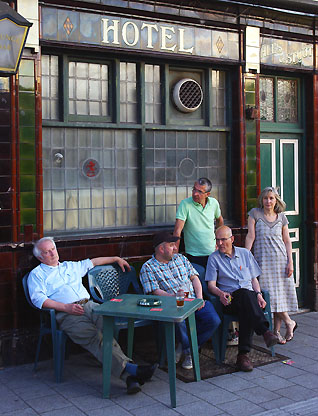The much-faded and painted advert for Guinness on the side of the
Vulcan has been there since at least the 1960s. Back then this typically
Cardiffian tavern was on the edge of a neck of tight working-class
tenements, just the other side of the rail track from the recently
slum-cleared district of Newtown. Cardiff was a dirty place, full
of smog and dust. The sprawling steelworks of East Moors and the docks
to their south provided a stream of men seeking sustenance and oblivion.
In the Vulcan you sat on wooden benches in working boots and working
clothes. There was sawdust on the floor.
Today, fifty years on, Newtown is a memory - replaced by industrial
units and a corporate hotel. The docks have been anodised, reduced
to a safety-conscious ghost of their former selves. East Moors is
the Ocean Way Industrial Park, full of warehouses and articulated
lorries. Even the terraces that once surrounded the Vulcan like ivy
have been flattened and turned into a clean, black-topped car park.
When I first discovered this 1853 pub it still had the legendary
sawdust and was still a home for working men. Railway workers, engineers
from BT opposite, prison guards, locals from Duffryn Street, Taff
Street and Pellet Street. I sat there with John Williams, the author
whose anthology of short fiction Wales Half-Welsh (Bloomsbury)
almost got titled Vulcanised. We were joined by a bunch of other writers
who felt more at home here than in the aluminium and glass vertical
drinkeries of Cardiff's town centre. (If you'd like to follow this
up then you can read more about the writers and the Vulcan in Peter
Finch's Real Wales, published December 2008 by Seren).
.The beer was good, there was a dart board, the juke wasn't intrusive.
Liz, the landlady, offered regulars bowls of chips and complimentary
sausages.
But then came the University of Glamorgan putting a tank on Cardiff
University's lawn by converting the old BT building into its splendid
new Atrium over the road. The School of Cultural Studies. Library,
students, light. The Pellet Street tower block of student flats (Ty
Pont Haearn) went up at incredible speed. After that came St David's
2 and the need for car parking. The surrounding streets were systematically
flattened yet the Vulcan survived. A pub in splendid isolation. A
Victorian gem for fans or a planning difficulty for developers. How
you viewed it depended on where you stood.
At the end of 2009 rumours abounded. The pub will be pulled down
next spring. Brains have sold out. In its place will be a multi storey
car park, social housing, another student tower block, bars, restaurants,
even Atrium 2, symbol of Glamorgan's unstoppable sweep to domination.
There's also a half-credible tale that St Fagans will purchase the
bricks and rebuilt the pub, restoring it to its Victorian splendour
in the heart of the museum. Iorwerth Peate would spin.
It is a function of developers to sweep all before them. Cardiff
has seen generations come and go, each cleaning the slate of everything.
The city today has almost nothing with a past. If you exclude the
Castle and St John's Church almost everything standing is recent.
We should preserve the pub by building round it and incorporating
it into the overall plan. It has happened before. Check the retained
Victorian frontage of the Altolusso block a few hundred yards on up
the road. We should retain the Vulcan's charm, its tourist attractability
(it's in the top fifty best UK pubs, according to CAMRA, the Campaign
for Real Ale) and its delight. Removing it even to the secure and
beerless pastures of St Fagans would be a crime.
Currently, in the heat of the economic breaking halt and the faltering
recovery, the Vulcan has won a three year reprieve from the brewery.
The solid campaign run by locals and politicians, activists and writers,
architects and lovers of Victoriana has paid off. For now. Keep drinking
and keep your eyes open.

Morgan Francis,
John Williams, Peter Finch (seated)
Ifor Thnomas, Charlotte Greig (standing)
outside the Vulcan, 2009
Peter
Finch

back
to the top